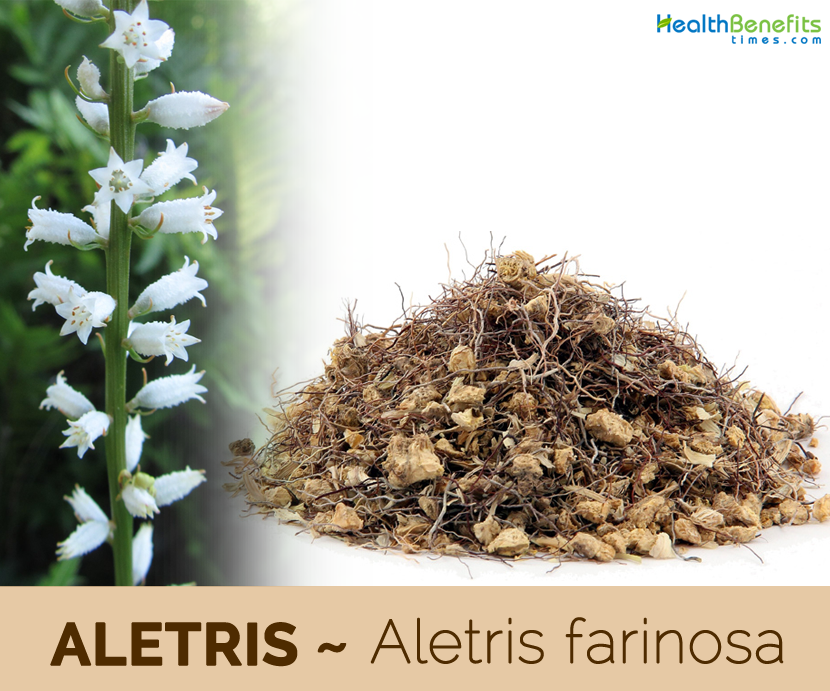| Aletris (white colic-root) Quick Facts | |
|---|---|
| Name: | Aletris (white colic-root) |
| Scientific Name: | Aletris farinosa |
| Origin | North America |
| Shapes | Ovate, tapering, coriaceous capsule, enclosed in a persistent envelope |
| Taste | bitter-sweet soapy taste |
Plant Description
Aletris is a low-growing, spreading perennial herb, with tuberous cylindrical, somewhat horizontal root, having many fibers from its lower surface. The plant grows in grassy or sandy woodlands, in dry or moist peats, sands and gravels, especially on the seashore. No stem is found in this plant. Leaves are lanceolate, acute, ribbed, sessile, or slightly sheathing at base, smooth and flat, pale colored, thin and coriaceous. Flower-stem are simple with remote scales, 1 to 3 feet high, topped with a spiked raceme of short-stalked, white, bell-shaped oblong flowers that blooms from May to August. The outer surface of these has a mealy frosted appearance. Fruit is an ovate, tapering, coriaceous capsule, enclosed in a persistent envelope. Seeds are numerous, ovate, ribbed, albuminous, fleshy, and oily.
History
Aletris is actually a North American plant which is recognized throughout the world in traditional folk medicine. Aletris occurs in dry, generally sandy soil from Maine to Minnesota, Florida, and Tennessee. It had been used by American Indians in the Carolinas as an antidiarrheal tea and in Appalachia for the management of rheumatisms and as a tonic and a sedative. It has been included in laxatives and has been used as an anti-flatulent (hence the name “colic root”) and antispasmodic. The roots and rhizomes are collected in the fall and dried for preservation.
Traditional Medicinal uses of Aletris
- It is use in treating cases of habitual miscarriages.
- Used for gynecological disorders or ‘female complaints’ in the US including dysmenorrhea, amenorrhea and prolapsed vagina complaints.
- It also promotes the appetite and is used in the treatment of diarrhea, rheumatism and jaundice.
- In large doses the fresh root is somewhat narcotic, emetic and cathartic.
- Decoction of the root is a bitter tonic and has been used for expelling flatulence and for various uterine disorders.
- It is used in the treatment of colic, though small doses, especially of the fresh root can cause hypo gastric colic.
- Root contains diosgenin, which has both anti-inflammatory and oestrogenic properties.
- Tea of the leaves has been used in the treatment of colic, stomach disorders, dysentery and bloody dysentery.
- Aletris was used to treat dysmenorrhea and relieve symptoms of menopause.
- Aletris can help relieve undesired symptoms of menopause such as hot flashes and vaginal dryness.
- Aletris may help relieve joint, muscle and tendon pain, and may also relieve constipation, diarrhea, gas and colic.
Precautions
- The fresh root is mildly poisonous causing abdominal discomfort.
- It’s best to avoid using colic root if you are pregnant or breast-feeding.
- Avoid in patients with a known allergy or hypersensitivity to true unicorn root, its constituents, or members of the Liliaceae family.
- Avoid in patients with inflammatory or infectious gastrointestinal conditions, as unicorn root may irritate the gastrointestinal tract.
Dosages
- The dried powdered root, 5 to 10 grains.
- Saturated tincture, 5 to 15 drops in water.
- Fluid extract, 1/2 to 1 drachm
References:
http://pfaf.org/User/Plant.aspx?LatinName=Aletris+farinosa
https://www.itis.gov/servlet/SingleRpt/SingleRpt?search_topic=TSN&search_value=42769#null
http://davesgarden.com/guides/pf/go/56480/
https://www.drugs.com/npp/aletris.html
http://www.botanical.com/botanical/mgmh/u/unitru02.html
http://www.theplantlist.org/tpl1.1/record/kew-294692
https://plants.usda.gov/core/profile?symbol=alfa2
https://en.wikipedia.org/wiki/Aletris_farinosa
http://www.illinoiswildflowers.info/prairie/plantx/colic_root.html
https://www.virtualmediclinic.com/library/aletris
http://www.registrelep-sararegistry.gc.ca/species/speciesDetails_e.cfm?sid=214
Comments
comments
